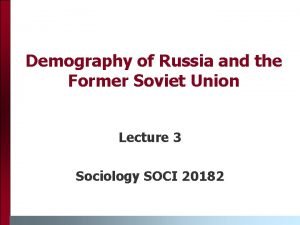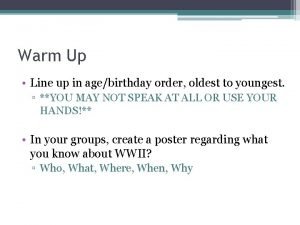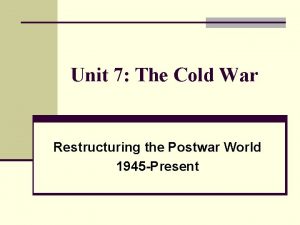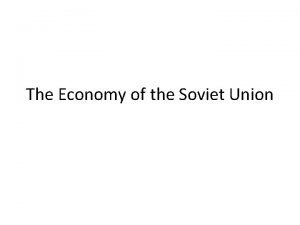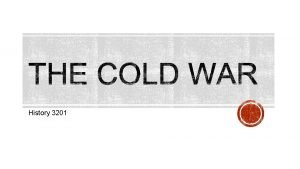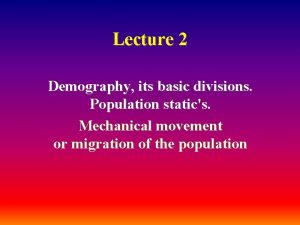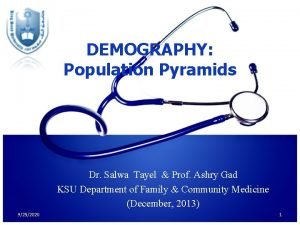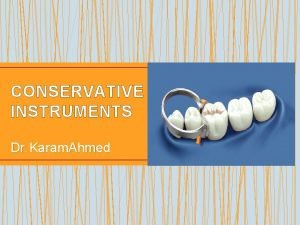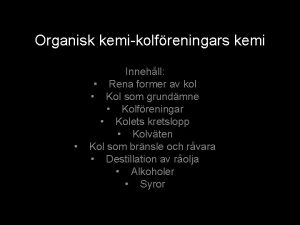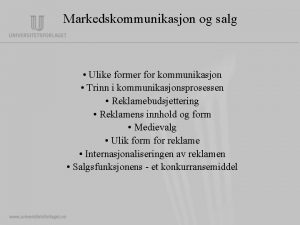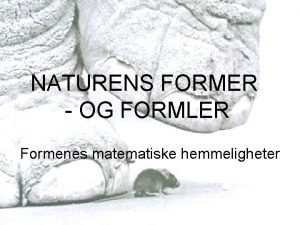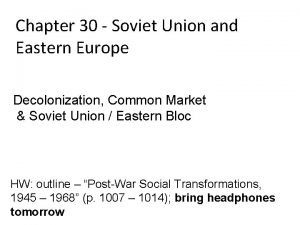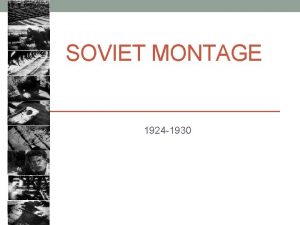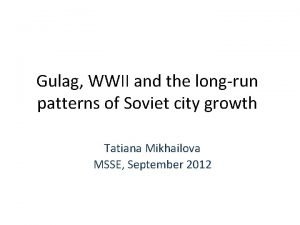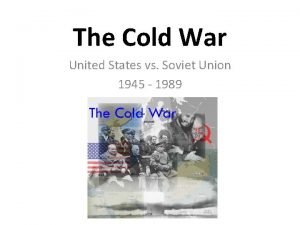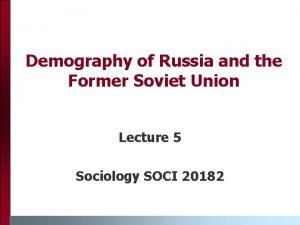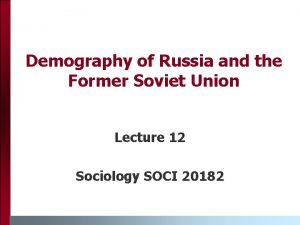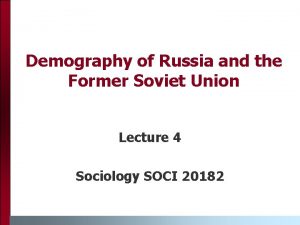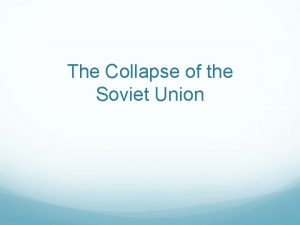Demography of Russia and the Former Soviet Union






















































































- Slides: 86

Demography of Russia and the Former Soviet Union Lecture 9 Sociology SOCI 20182

Which Statement is Wrong? (slide from alarmist lecture of Western researcher) Demographic Crisis in Russia n n n n Fertility and Birth Rates Declined Population Ageing Marriage Rates Declined Divorce Rates Increased Abortion Rates Increased Mortality Rates Increased Natural Growth of Population Declined

Factors and Trends of Mortality and Health in Russia

Gender gap in life expectancy n In 1994 gender gap in life expectancy in Russia reached 13. 7 years – the largest difference in life expectancy between sexes ever recorded

Life table probability of death for Russian men and women, 2005

Life table number of dying for Russian men and women, 2005

The Role of Education LRC – Lipid Research Clinic study cohort in Moscow and St. Petersburg

Protective role of education during 1992 -1994 crisis n Mortality of adult men with higher education level increased from 1989 to 1994 by 35% vs 57% for men with lower education level n Mortality of adult women with higher education level increased by only 8% compared to 30% for women with lower education level n Source: Shkolnikov et al. , SSM, 1998

Education and life expectancy at working ages (20 -69). Men, Russia Source: Shkolnikov et al. , SSM, 1998

Why educated people live longer in Russia? Decomposition by cause of death

The role of alcohol consumption in high mortality in Russia n n The consumption of alcohol has deep cultural roots in Russia where it typically accompanied celebrations, signified hospitality, and enhanced bonding among acquaintances and friends. It also was a tremendous sources of revenue for the Soviet state which exercised a monopoly on its production and distribution.

Dynamics of alcohol consumption in Russia n Liters of 100% alcohol person per year 1 – V. Treml; 2 – Goskomstat estimate; 3 -A. Nemtsov estimate; 4 - sales of alcohol

Alcohol is a driving force of mortality crisis in Russia

Gorbachev’s anti-alcohol campaign, 1985 -1987 n n n Official sales of alcohol fell 51% Real consumption fell 27% Fall of alcohol sales was compensated by alcohol selfproduction

Gorbachev anti-alcohol campaign n The favorable effect of the anti-alcohol campaign on Russian mortality was strong and rapid. Mortality began to decrease immediately after the introduction of restrictions on the sale of alcohol in June 1985 and continued month by month in parallel with the reduction in alcohol consumption (Shkolnikov and Vassin, 1994). The largest mortality decrease was observed at adult ages both for males and females during the year 1986. From 1984 to 1987 (mostly in 1986), life expectancy at birth rose from 61. 7 to 64. 9 years for males and from 73 to 74. 3 years for females. (From “Premature Death in the New Independent States, ” NAS, 1997)

Number of male deaths by month before and after the anti-alcohol campaign n Number of deaths in thousand

Contribution of different causes of death to changes in LE, men

Contribution of different causes of death to changes in LE, women

Major effects of anti-alcohol campaign n The highest decrease of mortality in regions with initial high levels of mortality at adult ages Regional inequality in mortality decreased Mortality decreased predominantly at middle adult ages due to reduction in external mortality and mortality from cardiovascular diseases

Results of anti-alcohol campaign Over 1 million lives were saved n Alcohol consumption was decreased but still remained high – 10. 5 -12. 6 liter person per year in 1986 -1991 n In 1984 estimated deaths due to direct and indirect effects of alcohol were 525, 000 deaths or 31. 8% of all registered deaths (4. 4% in USA, 3. 1% in Canada in 1995) n Anti-alcohol campaign decreased alcohol-related number of deaths by 200, 000 Estimates by A. Nemtsov. n

In 1992 and 1998 Russia experienced two serious economic crises accompanied by drop in personal income and rapid impoverishment

Alcohol and Inflation n In 1992 -1993 prices of alcohol increased much less than personal salaries and the general price index, which by June 1994 had increased to 1229 times its December 1992 level. Concurrently, prices of alcohol rose to 421 times their prior levels. It is not surprising that real alcohol consumption in Russia increased sharply during this period of economic crisis and reduction in real wages

Total and alcohol-related mortality during the market reforms n n Total number of deaths in thousand (left) Deaths from acute poisoning by alcohol (right)

Decline in alcohol quality during the market reforms n n In 1992 state monopoly on alcohol sales was abolished Self-production of alcohol became not profitable but over 20% of alcohol sales included technical alcohol Sample control tests showed that proportion of below quality standards alcohol was 5. 6% in 1992 and 30. 4% in 1994 Imported alcohol had even lower quality: 67. 2% below quality standards

--Change in all-cause mortality rates between 1990 and 1994 by age and sex, Russia Notzon, F. C. et al. JAMA 1998; 279: 793 -800. Copyright restrictions may apply.

Decomposition of changes in LE by cause of death, 1990 -1994

Alcohol and suicide n n Suicide (1) and accidental poisoning by alcohol (3) – left Alcohol psychoses (2) - right

Alcohol and cardiovascular mortality n n Alcohol intoxication is an additional risk factor for cardiovascular diseases During anti-alcohol campaign mortality from cardiovascular diseases decreased mainly due to atherosclerotic cardiosclerosis (by 19% in men) and stroke (by 8% in men)

n n Study of autopsies in Barnaul during 1990 -2004 (Zaridze et al. , 2009) Among 5732 autopsied men aged 3569 years who were reported to have died from circulatory diseases 49% had alcohol detected in their blood and in 21% concentration of ethanol was 4 g/l and higher (lethal dose) Of 5880 autopsied men aged 35 -69 years who were reported to have died from injuries 76% had alcohol in their blood and in 38% concentration of ethanol was 4 g/l and higher

What about alcohol surrogates? n n n Alcohol surrogates – non-food liquids containing ethanol (polishing liquids, perfume, pharmaceutical tinctures, etc. ) Alcohol surrogates are cheap, so they are attractive to poor persons. May be the only source of ethanol for impoverished persons. 47% of men who used surrogates were unemployed. Only 13% of men not used surrogates were unemployed

Northern Structure of Alcohol Consumption n An example of Sweden

Consumption of hard liquors and life expectancy

Alcohol-related policy

Explanations of Mortality Crisis in 1992 -1994 n n Psychological Stress (and alcohol) Hypothesis (Shapiro, 1995; Cornia, Paniccia, 1995; Shkolnikov et al. , 1998) Selection Hypothesis (‘selection of alcoholics’) by Avdeev, Blum, Zakharov, Andreev, 1997.

Other Hypotheses (less supported by evidence) n n n Mass impoverishment and malnutrition – if this hypothesis is true then infant mortality should increase Deterioration of the health care system – if this hypothesis is true then again infant mortality should increase Environmental pollution – environmental pollution should increase during 19921994 while in fact it decreased

Suggested Factors of Mortality Increase During the Transition Period Cardiovascular Diseases, Suicide, Alcohol-related causes Social Stress Rapid Impoverishment Cheap Alcohol Expensive Medicine Growth of Delinquency Injuries Diabetes, Asthma Selection Tuberculosis, Drug Dependence, Sexually Transmitted Diseases, Homicide

Life Expectancy in Russia Year Males Females China India 1992 1993 1994 1995 2000 2006 62. 0 58. 9 57. 6 58. 3 58. 8 60. 4 72. 0 62. 0 73. 8 71. 9 71. 2 71. 7 73. 2 75. 0 64. 0

Social Context of Trends in Russian Mortality

Transition period was accompanied by unprecedented growth of violence, crime rate and homicide mortality

Tendencies of Intentional Murders in Russia and the United States

Trends in Homicide Victimization Rates for Young and Middle-Aged Adults Data from Russian Vital Statistics Males Females

Age Profile of Homicide Mortality in Russia: 1981 -2002 Males Females

Traditionally high rate of alcoholrelated mortality increased further during the 1990 s

Age Profiles of Mortality from Accidental Poisoning by Alcohol Data from Russian Vital Statistics Males Females

Rapid increase in the number of abandon children and children without parental support during the last decade

Degradation of Mortality Statistics in Russia n n In 1997 Russian parliament made a decision that information about social status, education, marital status and ethnicity should not be indicated in medical death certificates (because of ‘privacy protection’). This decision made studies of mortality inequalities by social status very difficult

Social structure of young (16 -39) males died in 2004 in Kirov region

External deaths in marginal and socially adapted groups of men (%), Kirov region, 2004 Marginalized – unemployed or low-skilled workers

Period of reforms, started in the late 1980 s, resulted in qualitative changes in the pattern of Russian mortality. These changes may be summarized as marginalization of Russian mortality

The main characteristics of marginalization are n n n Degradation of registration of causes of death among socially disadapted Misrepresentation of real mortality pattern Formation of specific social portrait of deceased in the age groups of maximal risk (young and middle working ages)

It may be suggested that the growth of mortality in the 1990 s was determined by: n Widening of marginalized groups of population (more people became involved in these groups) n Accelerated growth of mortality in marginalized groups

Marginalization of Mortality is Accompanied by Return of Old Infections

Tuberculosis and Syphilis 1990 -1999

Age Profiles of Mortality from Tuberculosis Males Females

Prevalence of syphilis in Kazakhstan per 100, 000 (1991 -1999)





Causes of death and their classification n Established by the World Health Organization as International Classification of Diseases (ICD) n Has several revisions. The most recent revision is the 10 th revision. Adopted by most countries in the mid 1990 s

Classification of causes of death in Russia n n n Classification of causes of death used in the Soviet statistical forms was different from WHO classification. Form #5 (later called form C 51) had 185 causes of death. Main differences between WHO and Soviet classification are found in the groups of CVD and injuries

New classification of causes of death in Russia n n n After dissolution of the Soviet Union most FSU countries continued to use the old classification of causes of death In 1999 Russia adopted a new classification of causes of death corresponding to the 10 th ICD revision Still incompatible with the WHO classification

Major causes of death within the group of injuries. Men

Major causes of death within the group of injuries. Women

Degradation of mortality statistics in Russia

Pace of Growth of Age-Adjusted Mortality in 1989 -2000 for Classes of Causes of Death

Proportion of deaths from illdefined conditions is a measure of quality of mortality statistics In developed countries most deaths from ill-defined conditions are diagnosed at older ages

Is this increase in mortality from ill-defined conditions related to more cases of deaths from senility?

Age Profile of Mortality from Ill-Defined Conditions in Russia Males Females

Top Five Causes of Death for Young Adult Males (20 -24) 1990 2001 Injuries Neoplasms Symptoms, Signs and Ill. Defined Conditions Diseases of Circulatory System Infectious Diseases Symptoms, Signs and Ill. Defined Conditions Neoplasms Diseases of Nervous System and Sens. Organs Diseases of Respiratory System

Top Five Causes of Death for Young Adult Females (20 -24) 1990 2001 Injuries Neoplasms Diseases of Circulatory System Complications of Pregnancy and Childbearing Symptoms, Signs and Ill. Defined Conditions Diseases of Nervous System and Sens. Organs Infectious Diseases

What Causes of Death Are Hidden Behind the Ill-Defined Conditions?

We Used Individual Death Certificates With More Detailed Description of Circumstances of Death Collected by Kirov Department of Health Kirov is a Typical Russian Region with Lower than Average Mortality from Ill-Defined Conditions

Age-Adjusted Mortality from Injuries in 1996 for Russian Males Aged 0 -64 years Data from the Web. Atlas Project (http: //sci. aha. ru/ATL)

Deaths from Ill-Defined Conditions in Kirov Region of Russia in 2003 n n n Sudden infant death (R 95) 3. 3% Decomposition in water (river, well, pond) (R 99) 13. 0% Decomposition at home (R 99) 53. 5% Decomposition in garden, summer house (R 99) 1. 7% Decomposition in forest or field (R 99) 6. 0% Decomposition in nonresidential building, on the street (R 99) 12. 3% Decomposition in water pipe (R 99) 0. 7% Decomposition on the cemetery (R 99) 0. 3% Decomposition in bath, lavatory or barn (R 99) 1. 0% Decomposition in other place (R 99) 5. 5% unknown (R 99) 2. 3% senility (R 54) 0. 3%

Mortality in Moscow city

Ill-defined conditions and external deaths of undetermined intent are two sides of the same coin It appears that both causes of death may be used for concealing criminal cases of violent death

Top Five Causes of External Mortality in Russia and Moscow in 2001 Russia Moscow Suicide Accidental Falls Undetermined Injury Homicide All Other Accidental Causes Accidental Poisoning by Alcohol Homicide All Other Accidental Causes Suicide

Autopsies in Russia n n Autopsies are used to verify cause of death Autopsy is mandatory for violent death, death of woman during pregnancy, labor or postpartum period, death of infant below 1 year, death from cancer not supported morphologically, death from any infectious disease

Situation with medical examiner services n Only 34 -48% of jobs are filled by physicians n 38 -54% of jobs are filled by histologists n 35% of workers reached retirement age

Current trends in life expectancy

Current trends in life expectancy in Moscow and some Eastern European countries

Main features of recent improvement n n n Highest gains in working ages (1564) Main improvements due to causes directly related to alcohol, accidents and respiratory diseases These improvements may be related to the recent measures of increased control after alcohol production adopted in 2005

Additional factor – fluctuations in alcohol-related mortality Age-standardized mortality of men (per 100, 000) from accidental poisoning by alcohol

Improvement in life expectancy in 2005 -2006, Men

Improvement in life expectancy in 2005 -2006, Women
 Russia depopulation
Russia depopulation Meanwhile in soviet russia
Meanwhile in soviet russia Cold war timeline
Cold war timeline The soviet union what should textbooks emphasize
The soviet union what should textbooks emphasize What country made up the soviet union
What country made up the soviet union Chapter 19 section 3 the collapse of the soviet union
Chapter 19 section 3 the collapse of the soviet union Chapter 19 section 3 the collapse of the soviet union
Chapter 19 section 3 the collapse of the soviet union Soviet union develops atomic bomb
Soviet union develops atomic bomb Soviet union countries
Soviet union countries Soviet union
Soviet union Soviet union
Soviet union Cold war acrostic
Cold war acrostic Soviet union
Soviet union Containment ussr
Containment ussr Odderon particle
Odderon particle Which letter represents the danube river
Which letter represents the danube river Static demography
Static demography Cso business demography
Cso business demography Elements of demography
Elements of demography Rimland theroy
Rimland theroy Population demography definition
Population demography definition Sources of demographic data
Sources of demographic data Components of demography
Components of demography Slash and burn agriculture antonym
Slash and burn agriculture antonym Sql union minus intersect
Sql union minus intersect Sent her daughter to conjure spirits
Sent her daughter to conjure spirits Missy diwater the former platform diver
Missy diwater the former platform diver Louise klinge motivation
Louise klinge motivation My former speeches have but hit your thoughts
My former speeches have but hit your thoughts Ordinary hatchet excavator
Ordinary hatchet excavator Geometri för barn
Geometri för barn Drink before june 2012
Drink before june 2012 Energy is defined as
Energy is defined as Classification of instruments in operative dentistry
Classification of instruments in operative dentistry Kolets rena former
Kolets rena former Former xamarin cofounder icaza microsoft
Former xamarin cofounder icaza microsoft Effekthierarki
Effekthierarki Isaiah 42 9
Isaiah 42 9 Vacuum forming basics
Vacuum forming basics Patos etos logos
Patos etos logos Tourism law thailand
Tourism law thailand Former knowledge
Former knowledge Thailand former name
Thailand former name Imperativ
Imperativ Cage à lapin sur roulettes
Cage à lapin sur roulettes Which sentence uses commas correctly the former astronaut
Which sentence uses commas correctly the former astronaut Former allies clash
Former allies clash Indirect lost wax casting
Indirect lost wax casting Former situation
Former situation Former le conditionnel
Former le conditionnel Den instrumentelle ondskab
Den instrumentelle ondskab Matematiske former
Matematiske former Maturgas
Maturgas Muertos en la segunda guerra mundial
Muertos en la segunda guerra mundial Sino-soviet split timeline
Sino-soviet split timeline Juxtaposition meaning in film
Juxtaposition meaning in film Soviet formalism film
Soviet formalism film Post soviet states
Post soviet states Why cold war started
Why cold war started Ussr satellite states
Ussr satellite states Soviet montage
Soviet montage Soviet butterfly mine
Soviet butterfly mine Yanan soviet
Yanan soviet 1924 stalin becomes soviet dictator
1924 stalin becomes soviet dictator Sino-soviet relations timeline
Sino-soviet relations timeline Soviet gerontocracy
Soviet gerontocracy Who were the allies in world war ii
Who were the allies in world war ii Soviet
Soviet What does rosie the riveter symbolize
What does rosie the riveter symbolize The cold war thaws worksheet answers
The cold war thaws worksheet answers Rocky vs soviet
Rocky vs soviet Hình ảnh bộ gõ cơ thể búng tay
Hình ảnh bộ gõ cơ thể búng tay Frameset trong html5
Frameset trong html5 Bổ thể
Bổ thể Tỉ lệ cơ thể trẻ em
Tỉ lệ cơ thể trẻ em Gấu đi như thế nào
Gấu đi như thế nào Tư thế worm breton là gì
Tư thế worm breton là gì Chúa yêu trần thế alleluia
Chúa yêu trần thế alleluia Môn thể thao bắt đầu bằng từ chạy
Môn thể thao bắt đầu bằng từ chạy Thế nào là hệ số cao nhất
Thế nào là hệ số cao nhất Các châu lục và đại dương trên thế giới
Các châu lục và đại dương trên thế giới Công của trọng lực
Công của trọng lực Trời xanh đây là của chúng ta thể thơ
Trời xanh đây là của chúng ta thể thơ Mật thư anh em như thể tay chân
Mật thư anh em như thể tay chân Làm thế nào để 102-1=99
Làm thế nào để 102-1=99 Phản ứng thế ankan
Phản ứng thế ankan Các châu lục và đại dương trên thế giới
Các châu lục và đại dương trên thế giới
